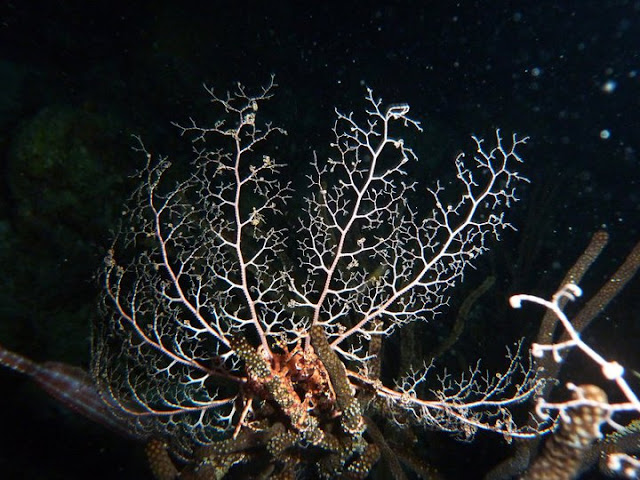Carnival under the Seas
We dress up to blend into a sea of beads and feathers. Two days in fancy dress is enough for most of us; and now the Carnival is over. However, there are marine creatures that spend their lives masquerading under the sea in the Caribbean. Dr Anjani Ganase presents some of these creatures in the Carnival that continues year round under the sea.
The Basket Star: Like
something out of an alien movie or an old mas band, the basket star can be
found wrapped in a tight ball under rocks and in sponges during the day, but at
night they extend ornate arms into the water column to trap plankton. Careful
not to shine the torch on them too long or they’ll curl up and retreat back
into hiding.
 |
| The Basket Star photo Anjani Ganase |
The Snake Eel is common on
Caribbean reefs and is the reason that many people believe sea snakes can be
found in the Caribbean. Alas the snake eel is a type of fish, and not a snake. There are two species of “snake eels”, the
sharptail eel and the golden spotted eel. Sea snakes are only found in the
Indo-Pacific region where snakes have adapted to living in the ocean.
 |
| The Snake Eel photo Ryan Mannette |
The Flying Gurnards are unique
winged fish, which use pectoral fins to glide over the bottom of the reef and
give divers an unexpected display silvery blue colour when they try to move
quickly. The flying gurnards also use these fins for hunting by sweeping the
sandy bottom in search of little critters to munch on.
Trumpetfish come in shades of
yellows, silver, reds and blues. Smaller trumpetfish can be found pivoting
upside down among the fronds of soft coral and swaying back and forth to
camouflage. They are in the same family as seahorses, and appear to be
stretched out versions of seahorses. However, don’t be fooled by their thin
morphology, they are voracious predators and use their narrow tube-like mouths
to suck their prey in.
 |
| Trumpetfish photo Anjani Ganase |
The collector urchin as it’s
name suggests tends to pick up random bits of debris – shells, algae, pebbles
among its spines intentionally and unintentionally. The collection keeps them
hidden from predators such as pufferfish and octopus. They are found in seagrass beds, especially in
the northern Caribbean region. Here is a sea urchin that has covered itself in
macroalgae.
 |
| The Collector Urchin photo Anjani Ganase |
The Spiny lobsters are the underwater
flag wavers of the reef. On rare occasion, you will find a lobster exposed on
the reef. Most of the time, for safety reasons, they’re often found under coral
overhangs with only their antennae sticking out, waving back and forth in the
water column.
As suggested by its name, the
Stonefish can be mistaken for an old rock underwater but don’t get caught out.
The pain from the barb of a stonefish is excruciating. Their cryptic patterns allow
them to pounce on unsuspecting prey. Stonefish are typically shades of reds and
brown. (Photo credit Anjani Ganase)
The Queen Angelfish is
literally the queen of carnival underwater. A fluorescent blue crown stands out
on top of the head, and is matched by the electric blue trim around the darker
blue body. The colouration is so striking that it is often difficult to get a
photograph that does it justice. (Photo credit Anjani Ganase)
 |
| Queen Angelfish photo Anjani Ganase |
A school of Creole Wrasse represents
underwater pretty masquerade. Large schools of up to a hundred blue and purple
creole wrasse can often be found flying above the reefs feeding on plankton as
they move through the water column.
The Stingray has a natural
undulating flow that can be an inspiration to many carnival costumes. Stingrays
undulate their bodies like a wave to propel forward, similar to the waves formed
by flags blowing in the wind.







